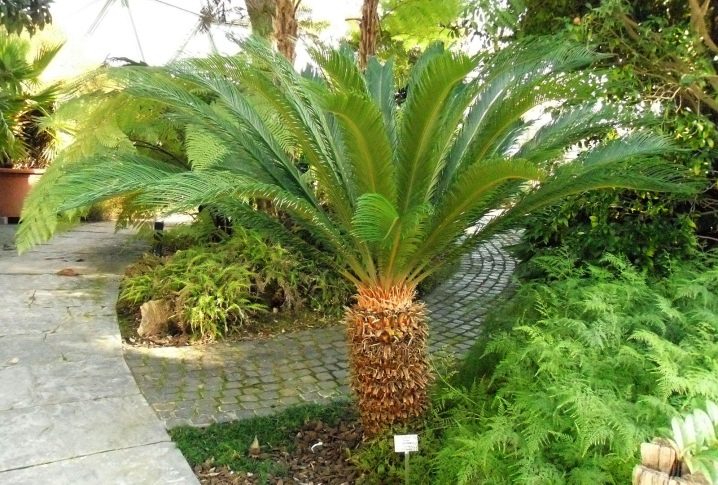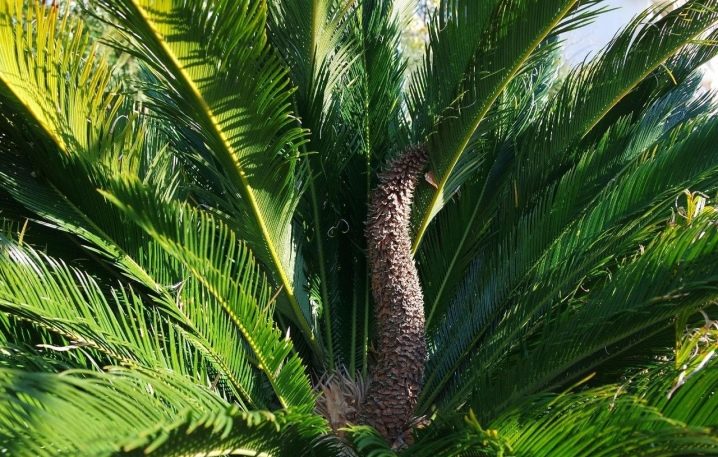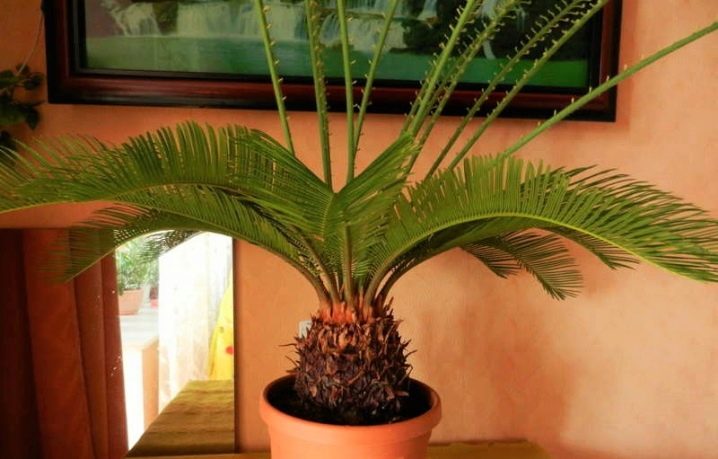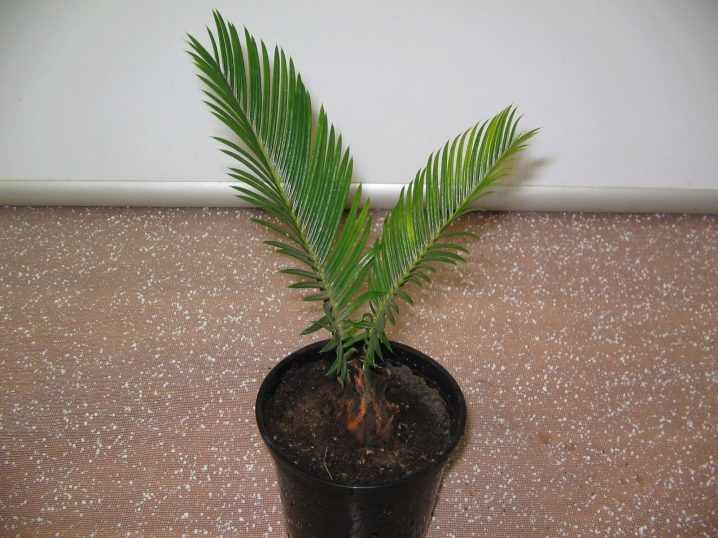Tsikas is revolution and its cultivation

Tsikas is a perennial tree-like plant that has been known since the Mesozoic. It belongs to the cycad family, and with its feathery leaves it resembles a palm tree. Therefore, the name sago palm is the middle name of the cicas.

The culture is not characterized by rapid growth, but visually it is still good: in an ascetic interior, in Nordic white, and in a boho style, it will look bright, interesting, solid.
general description
Tsikas is considered a close relative of the fern, and its appearance clearly shows this. It grows in the tropics and subtropics, most of all in China and Japan, and also on the Pacific islands. The leaves of the plant, tough and needle-like, rosette at the top of a massive trunk, look very exotic. The trunk itself is covered with rough dense bark.

In its natural environment, a cycad can grow up to 10 m, but in apartments and offices it is good if up to 70 cm. In a greenhouse, you can grow a two-meter drooping cycad. For a year, the increase will be only a couple of centimeters, plus one or two leaves, and each leaf will live no more than 3 years. The rhizome of the cicas is bulbous.
A very important point: all the vegetative organs of this culture have neurotoxins, which can be quite poisonous... This is fraught with burns, serious illness and, in difficult cases, even death. That is, growing cicas at home, you need to understand such a serious circumstance. When working with a plant, one must be careful, children and animals should not come into contact with it at all.
I must say that the cicassus is revolution - it is also not the easiest flower to care for. It develops slowly, and therefore it will seem to the grower that everything is in vain, the growth is worth it. We'll have to be patient. Breeding it is also very difficult, almost always breeding comes down to buying seeds. But the cicassus is a revolutionary plant in open ground, its domestic variety will not have such massive leaves. The leaf plates of indoor cicas are much thinner, they are fixed on the central axis. A cicassus growing for 10 years in a pot over all years can give 15 leaves in total.

The trunk of a domestic plant is not so developed, one might say that it is almost nonexistent. But the flower can still grow. It happens that it is more than a meter, although more often it is 50-70 cm.
Tsikas revolutiona has the following varieties:
-
cochlea - short-stemmed, with a rosette of 15 leaves, the leaves in the upper part and in the area of the central vein are covered with thorns;

-
toir - has a branched top and large seeds.

-
Siamese cycad - can grow up to 1.8 m, has particularly long leaves reaching 1.2 m (width - 20 cm).

- cicas rumph - has a beautiful emerald color, meter-long leaves with sparse lobes.

Why exactly the cicassus revolutiona (drooping) became popular as a house plant - probably because it is very compact. But you need to remember about the toxicity, and about the weak growth. Only the high decorative qualities of the cicassa can be higher than these arguments.

Landing
A transplant after purchase is needed for this plant only if its state is "sad", or the pot is initially small in size, and the culture in it is cramped. When transplanting, it is especially important not to injure the delicate root system of the cicas.

Basic transplant rules:
-
it is better to do this in the spring, young samples are transplanted no more than once a year, adults - no more than once every 3 years (or even 5 years);
-
the transshipment method is the most gentle, it allows you to protect the roots of the plant;
-
drainage should be not only in the bottom of the flowerpot, it should also be mixed with the substrate;
-
if the leaf buds of the plant have begun to grow, there can be no question of any transplant - the flower may simply stop growing;
-
a cicassus placed in a pot must be buried in the same way as in its previous "house", otherwise the roots may rot.


Attention! Since the flower is poisonous, all transplanting work must be carried out strictly with rubber gloves.
The cicas pot must be firm and deep. If it is too big, the soil in it may freeze. By the way, the soil itself should be light, with good aeration. The container must be rinsed, dried, filled with ready-made soil mixture. The lower old leaves of the plant should be cut off during transplantation. Slices must be treated with a disinfectant. There is no need to break off clods of earth on the roots. In a new container, the soil around the trunk will need to be filled up and tamped. And watering should come 24 hours after transplanting the flower, not earlier.

The nuances of care
A palm tree requires special conditions - a place so that its leaves can grow unhindered. And although they do not do it quickly, in cramped conditions it may not be possible. The cicassus will receive a bright green rich crown only if its care is comprehensive.

Conditions
In spring and summer, at an average of +20 degrees, the plant at home needs to create a humidity of 60%. To do this, you need to put water next to it, use a humidifier, and a spray bottle will help. Dust should be regularly wiped off the leaves. In the cold season, humidity is no longer so important for the culture, only if the container is not located close to the hot battery.
And to humidify too dry air, you can moss moss. And they also cover the ground, or even wrap the trunk. The cicassus also like a hot shower. The trunk and the soil are covered with a film, a container with a cycad is brought into the bathroom, and the crown itself is watered with a hot stream of water. For revoluta it is like revival, after that the leaves turn green, become brighter, we can expect a new tier.
The fact is that hot water softens the upper hard scales of the trunk, which became a barrier for young shoots.
Tsikas is not afraid of heat, it will even tolerate overheating in an apartment well. But the usual environment for humans is where the plant will actually have to exist. And it is better to maintain this environment so as not to “spoil” the flower. But below +14 degrees, the temperature should not fall. And also the plant will benefit from a long daylight hours. In summer, it is better for the cicassa to live on a sunny balcony. But there should not be much direct sun, 4 hours a day is enough to maintain the green leaves.

Watering
If the humidity in the space is optimal, in the summer you can water the revolut once a week, not more often. In winter, once every 2 weeks will be enough. When watering, water is never poured onto the stem. The liquid must first be drawn into a container, let it stand for a day. If excess water has collected in the pan, it is drained, and the pan is wiped.

In summer, the revolut can also be sprayed daily. In winter, when houses are heated intensively, and the level of humidity may be insufficient, you can spray the leaves of the plant twice a day.

Top dressing
Fertilizers are needed for cicas when it is in active growth. Enough mode 1 time per month. In winter and autumn, the plant is at rest, and therefore it definitely does not need any fertilizers.
When the plant does not need additional nutrition:
-
if it got sick - infections, pests, bacteria or rot have struck him;
-
when once every five years the cicas begins shed leaves, the life processes of the revolution stops;
-
when the flower transplanted, and he spends all his strength on adaptation.

Revolyuta takes nitrogen well and not only. You can soak a kilo of cow dung in water, and water it with this composition for 2 weeks. If you add 2 more tablespoons of superphosphate there, you can stimulate the growth of cicas.
Pruning
The plant needs it only from the point of view of sanitary safety.... For example, in order not to infect healthy leaves, not to lead to their decay, you need to clean dried and injured leaf plates. It is better to get rid of them without regret. Well, the contour of the plant is formed naturally, no pruning is needed for this.

Reproduction
It is almost impossible to propagate a cycad in room conditions. And even if you try to do this, only the seed method and the vegetative one are permissible. It is extremely difficult to get seeds at home, the plant simply does not form genitals, living not in its natural environment. Therefore, almost everyone buys seeds (be sure to check the germination period), they are soaked for a day, then they are buried in a suitable soil mixture, which is mixed with drainage, and kept in a greenhouse in bright light and high temperature. It may take 2 months for them to hatch. And then the usual process of rooting and planting will begin.

Another breeding method involves division of the appendix... At the base of the trunk, babies grow, that is, bulbous processes. They are removed very carefully, usually at the end of February or at the beginning of March (until the growth buds have awakened).

They can only be removed with a sterile instrument. The cut site should be treated with a pitch, you can simply use a fungicide.
The separated children themselves are also sprayed with a fungicide, then dried during the day, then sent to a growth stimulator. And after staying in it, they should also be dried. The seedlings must be buried in a peat-sand mixture, sent to a mini-greenhouse, so that they are very warm, moderately light, humid there, and they need to be watered there delicately. And so the long rooting process will begin and continue, which may well last 9 months. Once the seedling has formed its root, it can be sent to a separate container.

Diseases and pests
This plant, as noted above, is toxic. Therefore, it is not so afraid of pathogens.... But if the cicasus is weakened for various reasons, diseases may well attack it. Treatment always requires complex actions - from the correction of the regime (that is, you need to take care of it more carefully) to the appropriate chemical treatment.
That revolution, which is weakened by improper care, can become a victim of scale insects, spider mites, mealybugs and thrips - that is, a fairly common set of pests. They diligently suck out the juices from the plant, due to which it weakens even more and becomes close to death. Without insecticide treatment, this will definitely happen.


Among the diseases, root rot most often attacks the plant. As soon as its signs showed themselves, it is necessary to reduce watering, dry the soil. And then you need to really assess the scale of the defeat. In some cases, a cicassa transplant will be required. Sometimes herbicide treatment is sufficient.
Some "ailments" of the plant are mistaken for diseases, but this is not the case. If the leaves of the revolut turn yellow, this is not a fungus, but a consequence of a lack of lighting - you just need to change the light mode. And the cicassus will dry if the irrigation regime is violated, and if air stagnation is noted at the same time. Irrigation correction will be required, the organization of regular, sufficient ventilation.


But - it is worth saying again - in a house where there are small children and animals, they practically do not start a revolut, since its toxicity is dangerous. At the same time, plant toxins die during thermal exposure, therefore, in the tropics, cicas can even be eaten.





























































The comment was sent successfully.